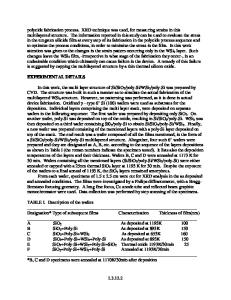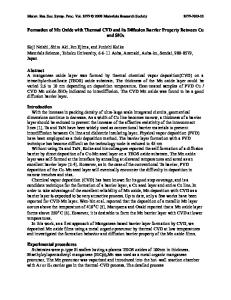Silicide formation in metal/Si structures and diffusion barrier properties of CVD tungsten films
- PDF / 731,977 Bytes
- 7 Pages / 593.28 x 841.68 pts Page_size
- 57 Downloads / 324 Views
INTRODUCTION Severe difficulties are encountered using aluminum in metal to silicon ohmic contact structures for very largescale integrated (VLSI) circuits. Contact layers and diffusion barriers must be inserted between aluminum and heavily doped Si in the source/drain regions of metaloxide-semiconductor (MOS) transistors to reduce the contact resistance and ensure the metallurgical integrity of the contact structures during subsequent heat treatments. Refractory metals such as tungsten or molybdenum having a work function close to the mid-gap of Si and low resistivity would appear to be suitable candidates to act as contact layers and diffusion barriers simultaneously.1 The most attractive method to produce thin films of conductive materials for metal to silicon contact structures is based on a selective deposition process2; i.e., the metal film is deposited on Si in the bottom of contact windows to the exclusion of the surrounding SiO2 surface. The major interest in the use of this process is to avoid several photolithography and etching steps usually required to delineate patterns in metal blanket films. Tungsten films can be selectively deposited on oxide patterned Si wafers via the Si and H2 reduction of WF6 at temperatures ranging from 280° to 300 °C using a hot wall CVD reactor: WF6 + 3/2Si -» W + 3/2SiF4
(1)
WF6 + 3H2 -* W + 6HF
(2)
156
http://journals.cambridge.org
J. Mater. Res., Vol. 4, No. 1, Jan/Feb 1989
Downloaded: 13 Mar 2015
The WF 6 -Si interaction results in deposition of the first layers of metal and formation of the W-Si interface when WF 6 -Ar or WF 6 -H 2 gas mixtures come in contact with Si substrates. The thickness of the initial W layer produced via the Si reduction of WF6 was investigated as a function of deposition temperature,3"7 native oxide thickness on the wafer surface,8"10 dose, implant type, and implantation damage in Si substrates. 4 " In general, 10 to 15 nm thick W films were formed on single crystal Si wafers cleaned by immersion in a diluted HF solution just prior to the metal deposition. The maximum thickness of these W films varied from 10 to 100 nm, depending upon the native oxide thickness on the Si surface.8'11 Thicker metal films were formed when the selective deposition proceeded via the H2 reduction of WF6. The W films produced by the Si reduction were found to be randomly oriented.12 The H2 reduction of WF6 resulted in the formation of W films with columnar grains having various preferred crystallographic orientations such as (100), (110), or (111).13"17 The texture of W films was observed to depend on different parameters including temperature, composition, and flow rate of the gas mixture. 13 However, the (100) texture was dominant at low deposition temperatures of about 300 °C.15 The barrier effects of W films on the interdiffusion of elements in A l / W / S i structures are expected to be dependent on various dominant parameters including the W film thickness, the microstructure of metal films, and the composition of Al-W and W-Si interfaces. 1989 Materials
Data Loading...










